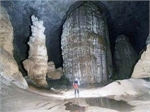|
Vietnamese woman
spends US$3,000 to see

Vietnamese woman spends US$3,000 to
see
To mark her thirtieth birthday, a
Vietnamese woman spent US$3,000 on a tour of
Nguyen M.H, a freelance advertising
executive working in
She decided to spend US$3,000 on an
adventure tour of Son Doong Cave in Phong Nha-Ke Bang National Park with
other Japanese and Canadian holidaymaker and US photographer Ryan Deboodt to
see the inside of the world’s largest cave.
Earlier, a foreign tourist group had
been the first to explore the
VNA to increase flights during
National Day holidays
Vietnam Airlines (VNA) has announced
that it will increase several flights during the Vietnam National Day
holidays from August 30 to September 3.
VNA will increase flights on 10
domestic routes, including
Vietnam Airlines will increase
285,623 seats on domestic and international flights, an increase of 22
percent compared with regular schedule, and an increase of 21 percent
compared to the same period last year.
The Vietnam National Administration
of Tourism (VNAT) highlighted the importance of the country becoming a
competitive, professional trademark in the travel industry during a seminar
last week on “Positioning the Vietnam Tourism Brand”.
The event was concerned with the
implementation of
Speaking at the seminar, head of VNAT
Nguyen Van Tuan, said that Vietnam needed to further develop as a tourism
trademark and he stressed this as a key factor in regional competitiveness.
Over the last several years, tourism growth and development has been
inconsistent, with cultural and historic sites failing to popularise and a
shaky national marketing platform.
Vu The Binh, chairman of the Vietnam
Tourism Association, also noted that building
Binh added that the industry
introduced many promotions, marketed destinations and sites, and developed
infrastructure, but had not done so consistently so as to present the
“A national tourism brand is the same
as any other product or service,” said Binh, “it needs to be apparent and
attractive to consumers.”
Florian Sengstschmid, a branding
expert from the EU’s Environmentally and Socially Responsible Tourism
Capacity Development Programme (ESRT), elaborated that
He shared four important elements for
developing an effective tourism brand: logo, experience, images, and stories.
He presented a sample logo “
In August, more than 130 participants
from 63 provincial departments of culture, sports and tourism, tourism
promotion centres, and other relevant entities attended a series of intensive
training courses on Tourism Destination Marketing, organised by the VNAT and
supported by ESRT.
Meanwhile, Nguyen Quoc Ky, general
director of Vietravel said that to build national tourism brand, the industry
would rather concentrate in the most key element- food to compete with other
countries than invest in many things that would spend huge investment capital
and time.
He added that
Tran Van Long, general director of
Viet Media Travel, shared a different viewpoint, saying that famous destinations
such as
According to Tuan, the tourism
strategy through 2020 is aimed at strengthening advertising campaigns and
encouraging businesses and other organisations to work together to promote a
consistent national tourism brand and concept. The tourism industry planned
to serve 7.2 million international visitors and 35 million domestic tourists
in 2013 with the revenue reaching $9.5 billion, an 18.75 per cent increase
against 2012.
The Hue Relics Conservation Centre
will launch a tourism promotion month from September 2-30 to lure more
tourists to the Complex of Hue Monuments, a world cultural heritage in the
central
The programme marks 20 years since
the complex was recognised as a world cultural heritage by UNESCO, said the
centre’s director Phan Thanh Hai on August 22.
During the month, the centre will
offer free tour guides to each group of up to 30 visitors, free tickets to
students and a free electric bus service from Dai Noi (Mandarin’s House) to
the
Holidaymakers will also enjoy a 50
percent reduction in ticket prices for performances of nha nhac (
A number of exhibitions are scheduled
to be held from September 6-30, showcasing administrative records of the
Nguyen dynasty and other artefacts as well as photos capturing
The month also features field trips
to cultural heritage sites, a painting contest, meetings, gala dinners,
sports games and artistic performances.
The centre said by July 19, more than
1.14 million people, half of them from overseas, visited the Complex of Hue
Monuments. Revenue from tourism exceeded 74 billion VND, or 70.7 percent of
the yearly target.
Source: SGT/SGGP/VNA/VNS/VOV/ND
|
Thứ Ba, 27 tháng 8, 2013
Đăng ký:
Đăng Nhận xét (Atom)
Không có nhận xét nào:
Đăng nhận xét